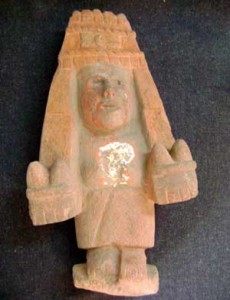- Farmers headed into Europe. As it were.
- BBC slideshow on drought in NE Kenya and its effect on pastoralists.
- Might they have something to learn from the Sedillo Cattle Association at Laguna Pueblo, NM?
- The script of a radio programme about drought-resistant sorghum in Karamoja, northern Uganda. I can’t find the programme itself.
- The genetics of red-fleshed apples.
- Just 3 genes account for all dog fur phenotypes. But “[w]hat’s important for human health is the way we found the genes involved….rather than the genes themselves.”
- Pear cider makes a comeback.
Bolivians going back to their roots
I blogged a couple years ago about what might be called the “1491 controversy,” which hinges on whether you think the Amazon and adjacent areas were densely populated and closely managed before Columbus arrived, or an unproductive, largely pristine wilderness. One of the areas in question is the basin of the Beni River in Bolivia. Whatever your stand on the 1491 debate, it is undeniable that the Beni is a heavily modified landscape.
Shallow floodwaters cover much of the low-lying lands in the Llanos de Moxos during part of the rainy season. The rest of the year, dry conditions prevail and water is scarce. The alternation between seasonal flooding and seasonal drought, combined with poor soil conditions and lack of drainage, make farming in these areas difficult. The ancient inhabitants of the area created an agricultural landscape to solve these problems and make the area highly productive. They constructed a system of raised fields, or large planting surfaces of earth elevated above the seasonally flooded savannas and wetlands. Experiments have shown that the raised fields improve soil conditions and provide localized drainage and the means for water management, nutrient production, and organic recycling.
Well, Bolivian researchers are now suggesting that farmers return to these “camellones,” or raised fields, to harness the seasonal flooding, rather than succumbing to its depredatioons. Oxfam is supporting the project. The BBC was there.
If, as predicted by many experts, the cycles of El Niño/La Niña are going to increase in intensity and frequency, then the project has the capacity to help poor families cope better with the extreme weather events and unpredictable rainfall that are to come.
It would also allow them to cut down on fertilizers, and dabble in aquaculture. There is some scepticism, which has to do with the necessary investment in time and effort. But early results show gains in productivity, apparently, although it’s unclear from the BBC article what exactly is being compared. Anyway, there is much optimism.
This process could be repeated in various parts of the world with similar conditions to the Beni like parts of Bangladesh, India and China.
In the words of local farmer Maira Salas: “We are only just now learning how our ancestors lived and survived.” Well, yes, but with a difference. Some of the crops that are been grown in the camellones are exotic, which is fine, of course. But will there also be a revival of neglected traditional indigenous crops?
Silphium rediscovered?
Luigi dug up this great article — Devil’s Dung: The World’s Smelliest Spice — which reveals more about asafoetida than you could possibly ever have wanted to know. Lord but it is strange stuff to cook with, and yet I do like what it does for a dish. But I digress. Buried in a sidebar near the bottom of the page is a claim, complete with coy question mark, that silphium, most prized spice of ancient Rome, might be alive and well. The article recounts the history of silphium, and how it was believed to have gone extinct by the 1st century CE, so I won’t repeat that here. It also mentions the possibility that Cachrys ferulacea and ancient silphium are one and the same. ((GBIF doesn’t yet know about the record from Cyrenia.)) Personally, I have no idea, and I’m not even sure I know how one would know, but I’m intrigued. Thanks Luigi.
Chicomecoatl the Maize Goddess restored
Anthropologists and geneticists see the origin of agriculture in different ways
Dorian Fuller has answered Paul Gepts’ comment on Dorian’s post at The Archaeobotanist on the multiple origin of agriculture, which I originally blogged about a few days ago. Let’s remind ourselves of the argument.
This was Dorian’s parting statement on the original post:
…agriculture, like modern human behaviour, was not a one time great invention, but the product of social and environmental circumstances to which human groups with the same cognitive potential responded in parallel ways.
Paul Gepts countered with this:
As a geneticist, I am somewhat surprised that the issue of parallel inventions of agriculture is still an issue… biochemical and molecular data also show distinct, and likely, independent domestication in different geographical areas, not among only among different crops, but also within a crop gene pool.
And now Dorian again:
My sense is that most of the genetics community has shifted towards seeing multiple areas of independent origin, but within archaeology there is still a penchant for reducing historical complexities to as few origins as possible — often focusing on where more archaeological research has taken place rather than considering other forms of evidence (biogeography, genetics) that should encourage us to take up research in the less-explored or unexplored areas.
Read the full exchange.
